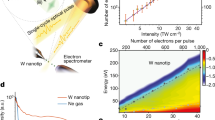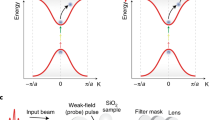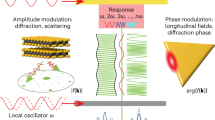Abstract
The primary step of almost any interaction between light and materials is the electrodynamic response of the electrons to the optical cycles of the impinging light wave on sub-wavelength and sub-cycle dimensions1. Understanding and controlling the electromagnetic responses of a material2,3,4,5,6,7,8,9,10,11 is therefore essential for modern optics and nanophotonics12,13,14,15,16,17,18,19. Although the small de Broglie wavelength of electron beams should allow access to attosecond and ångström dimensions20, the time resolution of ultrafast electron microscopy21 and diffraction22 has so far been limited to the femtosecond domain16,17,18, which is insufficient for recording fundamental material responses on the scale of the cycles of light1,2,10. Here we advance transmission electron microscopy to attosecond time resolution of optical responses within one cycle of excitation light23. We apply a continuous-wave laser24 to modulate the electron wave function into a rapid sequence of electron pulses, and use an energy filter to resolve electromagnetic near-fields in and around a material as a movie in space and time. Experiments on nanostructured needle tips, dielectric resonators and metamaterial antennas reveal a directional launch of chiral surface waves, a delay between dipole and quadrupole dynamics, a subluminal buried waveguide field and a symmetry-broken multi-antenna response. These results signify the value of combining electron microscopy and attosecond laser science to understand light–matter interactions in terms of their fundamental dimensions in space and time.
This is a preview of subscription content, access via your institution
Access options
Access Nature and 54 other Nature Portfolio journals
Get Nature+, our best-value online-access subscription
$29.99 / 30 days
cancel any time
Subscribe to this journal
Receive 51 print issues and online access
$199.00 per year
only $3.90 per issue
Buy this article
- Purchase on Springer Link
- Instant access to full article PDF
Prices may be subject to local taxes which are calculated during checkout




Similar content being viewed by others
Data availability
The data supporting the findings of this study are available from the corresponding authors upon request.
References
Krausz, F. & Ivanov, M. Attosecond physics. Rev. Mod. Phys. 81, 163–234 (2009).
Kienberger, R. et al. Steering attosecond electron wave packets with light. Science 297, 1144–1148 (2002).
Khorasaninejad, M. & Capasso, F. Metalenses: versatile multifunctional photonic components. Science 358, eaam8100 (2017).
Fei, Z. et al. Gate-tuning of graphene plasmons revealed by infrared nano-imaging. Nature 487, 82–85 (2012).
Shaltout, A. M., Shalaev, V. M. & Brongersma, M. L. Spatiotemporal light control with active metasurfaces. Science 364, eaat3100 (2019).
Grinblat, G. Nonlinear dielectric nanoantennas and metasurfaces: frequency conversion and wavefront control. ACS Photonics 8, 3406–3432 (2021).
Yuan, G. H. & Zheludev, N. I. Detecting nanometric displacements with optical ruler metrology. Science 364, 771–775 (2019).
Deng, S. et al. Ultranarrow plasmon resonances from annealed nanoparticle lattices. Proc. Natl Acad. Sci. USA 117, 23380–23384 (2020).
Davis, T. J. et al. Ultrafast vector imaging of plasmonic skyrmion dynamics with deep subwavelength resolution. Science 368, eaba6415 (2020).
Ludwig, M. et al. Sub-femtosecond electron transport in a nanoscale gap. Nat. Phys. 16, 341–345 (2020).
Müller, M., Paarmann, A. & Ernstorfer, R. Femtosecond electrons probing currents and atomic structure in nanomaterials. Nat. Commun. 5, 5292 (2014).
Joo, W.-J. et al. Metasurface-driven OLED displays beyond 10,000 pixels per inch. Science 370, 459–463 (2020).
Li, Z. et al. Meta-optics achieves RGB-achromatic focusing for virtual reality. Sci. Adv. 7, eabe4458 (2021).
Wang, L.-M. & Petek, H. Focusing surface plasmon polariton wave packets in space and time. Laser Photonics Rev. 7, 1003–1009 (2013).
Groß, P. et al. Plasmonic nanofocusing – grey holes for light. Adv. Phys. X 1, 297–330 (2016).
Barwick, B., Flannigan, D. J. & Zewail, A. H. Photon-induced near-field electron microscopy. Nature 462, 902–906 (2009).
Madan, I. et al. Holographic imaging of electromagnetic fields via electron-light quantum interference. Sci. Adv. 5, eaav8358 (2019).
Kurman, Y. et al. Spatiotemporal imaging of 2D polariton wave packet dynamics using free electrons. Science 372, 1181–1186 (2021).
le Feber, B., Rotenberg, N., Beggs, D. M. & Kuipers, L. Simultaneous measurement of nanoscale electric and magnetic optical fields. Nat. Photonics 8, 43–46 (2014).
Baum, P. & Krausz, F. Capturing atomic-scale carrier dynamics with electrons. Chem. Phys. Lett. 683, 57–61 (2017).
Zewail, A. H. Four-dimensional electron microscopy. Science 328, 187–193 (2010).
Miller, R. J. D. Femtosecond crystallography with ultrabright electrons and X-rays: capturing chemistry in action. Science 343, 1108–1116 (2014).
Paul, P. M. et al. Observation of a train of attosecond pulses from high harmonic generation. Science 292, 1689–1692 (2001).
Ryabov, A., Thurner, J. W., Nabben, D., Tsarev, M. V. & Baum, P. Attosecond metrology in a continuous-beam transmission electron microscope. Sci. Adv. 6, eabb1393 (2020).
Tsarev, M. V., Ryabov, A. & Baum, P. Free-electron qubits and maximum-contrast attosecond pulses via temporal Talbot revivals. Phys. Rev. Res. 3, 043033 (2021).
Feist, A. et al. Quantum coherent optical phase modulation in an ultrafast transmission electron microscope. Nature 521, 200–203 (2015).
Vanacore, G. M. et al. Ultrafast generation and control of an electron vortex beam via chiral plasmonic near fields. Nat. Mater. 18, 573–579 (2019).
Harvey, T. R. et al. Probing chirality with inelastic electron-light scattering. Nano Lett. 20, 4377–4383 (2020).
Ayuso, D., Ordonez, A. F., Decleva, P., Ivanov, M. & Smirnova, O. Enantio-sensitive unidirectional light bending. Nat. Commun. 12, 3951 (2021).
Collins, J. T. et al. Chirality and chiroptical effects in metal nanostructures: fundamentals and current trends. Adv. Opt. Mater. 5, 1700182 (2017).
Lee, D. Y. et al. Adaptive tip-enhanced nano-spectroscopy. Nat. Commun. 12, 3465 (2021).
Kuzyk, A. et al. DNA-based self-assembly of chiral plasmonic nanostructures with tailored optical response. Nature 483, 311–314 (2012).
Ehberger, D., Ryabov, A. & Baum, P. Tilted electron pulses. Phys. Rev. Lett. 121, 094801 (2018).
Ryabov, A. & Baum, P. Electron microscopy of electromagnetic waveforms. Science 353, 374–377 (2016).
Morimoto, Y. & Baum, P. Single-cycle optical control of beam electrons. Phys. Rev. Lett. 125, 193202 (2020).
Hassan, M. T., Liu, H., Baskin, J. S. & Zewail, A. H. Photon gating in four-dimensional ultrafast electron microscopy. Proc. Natl Acad. Sci. USA 112, 12944–12949 (2015).
Kozák, M. All-optical scheme for generation of isolated attosecond electron pulses. Phys. Rev. Lett. 123, 203202 (2019).
Gao, W. et al. Real-space charge-density imaging with sub-ångström resolution by four-dimensional electron microscopy. Nature 575, 480–484 (2019).
Bogaerts, W. et al. Programmable photonic circuits. Nature 586, 207–216 (2020).
Peller, D. et al. Sub-cycle atomic-scale forces coherently control a single-molecule switch. Nature 585, 58–62 (2020).
Feist, A. et al. Cavity-mediated electron-photon pairs. Science 377, 777–780 (2022).
Weninger, C. & Baum, P. Temporal distortions in magnetic lenses. Ultramicroscopy 113, 145–151 (2012).
Kreier, D., Sabonis, D. & Baum, P. Alignment of magnetic solenoid lenses for minimizing temporal distortions. J. Opt. 16, 075201 (2014).
Mairesse, Y. & Quéré, F. Frequency-resolved optical gating for complete reconstruction of attosecond bursts. Phys. Rev. A 71, 011401 (2005).
Priebe, K. E. et al. Attosecond electron pulse trains and quantum state reconstruction in ultrafast transmission electron microscopy. Nat. Photonics 11, 793–797 (2017).
Morimoto, Y. & Baum, P. Diffraction and microscopy with attosecond electron pulse trains. Nat. Phys. 14, 252–256 (2018).
Baum, P. & Zewail, A. H. Attosecond electron pulses for 4D diffraction and microscopy. Proc. Natl Acad. Sci. USA 104, 18409–18414 (2007).
Park, S. T. & Zewail, A. H. Photon-induced near-field electron microscopy: mathematical formulation of the relation between the experimental observables and the optically driven charge density of nanoparticles. Phys. Rev. A 89, 013851 (2014).
Werner, W. S. M., Glantschnig, K. & Ambrosch-Draxl, C. Optical constants and inelastic electron-scattering data for 17 elemental metals. J. Phys. Chem. Ref. Data 38, 1013–1092 (2009).
Weaver, J. H., Olson, C. G. & Lynch, D. W. Optical properties of crystalline tungsten. Phys. Rev. B 12, 1293–1297 (1975).
Morimoto, Y. & Baum, P. Attosecond control of electron beams at dielectric and absorbing membranes. Phys. Rev. A 97, 033815 (2018).
Rakić, A. D., Djurišić, A. B., Elazar, J. M. & Majewski, M. L. Optical properties of metallic films for vertical-cavity optoelectronic devices. Appl. Opt. 37, 5271–5283 (1998).
Acknowledgements
This research was supported by the German Research Foundation (DFG) through SFB 1432, by the Vector foundation and by the Dr K. H. Eberle Foundation. We thank A. Bähring for help with membrane preparation.
Author information
Authors and Affiliations
Contributions
P.B. conceived the experiment. L.S., D.N., J.K. and A.R. prepared the nanostructured materials. A.R., D.N. and J.K. constructed the experiment. D.N., J.K. and A.R. obtained data and made analyses. J.K. and L.S. performed numerical calculations. All authors wrote the paper.
Corresponding authors
Ethics declarations
Competing interests
The authors declare no competing interests.
Peer review
Peer review information
Nature thanks Kangpeng Wang and the other, anonymous, reviewer(s) for their contribution to the peer review of this work.
Additional information
Publisher’s note Springer Nature remains neutral with regard to jurisdictional claims in published maps and institutional affiliations.
Extended data figures and tables
Extended Data Fig. 1 Numerical simulations of light-cycle contrast on a tungsten needle.
Simulated electron energy changes on a tungsten nanotip for varying times within one optical cycle of the exciting laser wave. The dimensions of the needle correspond to the experiment of Fig. 1.
Extended Data Fig. 2 Numerical simulation for explanation of phase velocities and chiral sensitivity.
a, Simulated field-cycle-contrast images for laser incidence from the upper/right direction for explaining the measured super-luminal phase velocities of Fig. 2. b, Simulated field-cycle-contrast images for laser incidence from the upper/left direction. c, Simulated field-cycle contrast as a function of time. d, Time-frozen electric field component Ez around the needle (black circle) in right-handed light. In contrast to Fig. 2f, the laser impinges now from a slanted direction (k-vector in the xz-plane in the coordinates of Fig. 1f). Black arrows, rotation of the field cycles when time proceeds. Pink, purple, trajectories to the left or to the right of the tip. The left part (pink) counter-propagates with the field while the right part (purple) can surf. e, Simulated g-factor changes on the left side (pink) and on the right side (purple) as a function of the propagation time. The results are almost identical to the data of Fig. 2f. The slanted incidence of the laser in the experiment of Fig. 2 is therefore not relevant for the appearance of chirality in our attosecond electron microscopy.
Extended Data Fig. 3 Numerical simulations of light-cycle contrast in a dielectric nanoresonator.
Simulated electron energy changes as a function of space and time within half a cycle of the excitation field. The black dashed lines highlight the propagating wave front of the buried field cycles. The black arrows indicate the field direction and highlight a dipolar and quadrupolar mode at different times. The slit dimensions and membrane properties correspond to the experiment of Fig. 3.
Extended Data Fig. 4 Numerical simulations of the time-resolved dynamics of a nanophotonic meta-atom.
a, Amplitude map of the simulated field oscillations. The slit dimensions and positions correspond to the experiment of Fig. 4. The pattern resembles the experimental data but with shifted interference positions (grey circle). b, Simulated time traces (blue) of the field oscillations at selected interference maxima (1–4). For comparison, the measured time traces from Fig. 4 are reproduced (black). While delays 3 and 4 correspond well to the experiment, delays 1 and 2 show discrepancies, potentially originating from nonplanar surface effects, roughness of the structure, modified refractive indices around the slits, wedged slit walls or related effects.
Extended Data Fig. 5 Comparison of the practical signal strengths in continuous and attosecond electron microscopy regimes.
a, Image of a needle with a continuous beam of electrons at an exposure time of 0.5 s. b, Same image acquired with our attosecond electron pulses at double the exposure time, 1 s. c, Energy-filtered image changes at a spectral cutoff energy of ~1 eV at a chosen time delay. Exposure time, 5 s; scale bar, 100 nm.
Extended Data Fig. 6 Optimum attosecond contrast.
a, Typical laser-modulated electron energy spectrum with sideband peaks at multiples of the photon energy ħω, where \(\omega =2\pi c/\lambda \). The grey area denotes the energy filtering in the experiment. The filter rejects electron with ΔE < Ecut and only transmits electrons with ΔE > Ecut (white area). b, Measured field-cycle contrast as a function of the upper energy slit position Ecut in the energy filter. Neither a too low cutoff (<0.4 eV) nor a too large cutoff (>2 eV) produce a useful contrast. The dashed line indicates the photon energy. c–e, Examples of energy-filtered images at Δt = 0.6 fs for different cutoff energies of Ecut = 1.85 eV, Ecut = 1.05 eV and Ecut = 0.25 eV, respectively. Note the changes of signal strength and background noise. Scale bar, 500 nm.
Extended Data Fig. 7 Mode strengths of the singular value decomposition from the dataset of Fig. 3.
The first and the second mode are the quadrupole and the dipole while higher-order modes >2 are associated with noise.
Supplementary information
Supplementary Video 1
Field dynamics of a plasmonic needle. Electric near fields as a function of time; see also Fig. 1g.
Supplementary Video 2
Chiral fields around a slit-modified tip. Electric near fields as a function of time; see also Fig. 2b.
Supplementary Video 3
Resonator modes of a dielectric nanoslit. Electric near fields as a function of time; see also Fig. 3b.
Supplementary Video 4
Interference around multi-slit metastructure. Time-resolved electric near fields; see also Fig. 4a.
Rights and permissions
Springer Nature or its licensor (e.g. a society or other partner) holds exclusive rights to this article under a publishing agreement with the author(s) or other rightsholder(s); author self-archiving of the accepted manuscript version of this article is solely governed by the terms of such publishing agreement and applicable law.
About this article
Cite this article
Nabben, D., Kuttruff, J., Stolz, L. et al. Attosecond electron microscopy of sub-cycle optical dynamics. Nature 619, 63–67 (2023). https://doi.org/10.1038/s41586-023-06074-9
Received:
Accepted:
Published:
Issue Date:
DOI: https://doi.org/10.1038/s41586-023-06074-9
This article is cited by
-
Femtosecond electron beam probe of ultrafast electronics
Nature Communications (2024)
-
Attosecond electron microscopy by free-electron homodyne detection
Nature Photonics (2024)
-
Attosecond movies of nano-optical fields
Nature Photonics (2023)
Comments
By submitting a comment you agree to abide by our Terms and Community Guidelines. If you find something abusive or that does not comply with our terms or guidelines please flag it as inappropriate.



